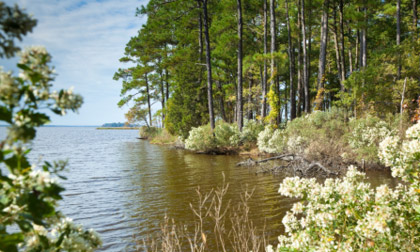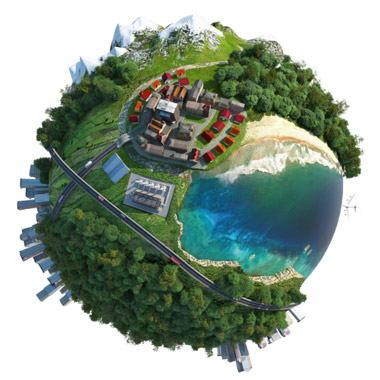Greening a Growing Infrastructure Crisis
In President Barack Obama’s 2012 State of the Union address he declared, “There’s never been a better time to build.” I could not agree more. “So much of America needs to be rebuilt,” the President continued, “We’ve got crumbling roads and bridges.” The President is absolutely right about the crisis, which is why now is the time to invest significantly in our country’s crumbling infrastructure, incorporating green infrastructure techniques and expanding innovation through research and development. These are the right priorities for Congress and the American people. We have a chance to create jobs and grow our economy in the short-term while laying a strong foundation for long-term economic development and global competitiveness in the 21st Century.
Our nation’s infrastructure is in disrepair. The American Society of Civil Engineers gives America’s overall infrastructure a “D” grade and estimates $2.2 trillion is needed in the next five years to make necessary upgrades. Within the next decade, that total skyrockets to more than $7 trillion for roads, bridges, aviation and transit. Combine this great need for investment with a ready and able workforce, and there is no doubt that making infrastructure investments must be a top priority. According to the Department of Labor, the nation’s construction sector was particularly hard hit by the economic downturn, losing more than 1.9 million jobs since December, 2007. Four years later, 1.3 million construction workers are still unemployed.
Our water and sewer systems possess the greatest urgency for public health and opportunity to achieve our stated goals. Our overall infrastructure needs remain great, but Ashley Halsey III of the Washington Post wrote recently, “Although they are out of sight and out of mind, except when they spring a leak, water and sewer systems are more vital to civilized society than any other aspect of infrastructure. Without an ample supply of water, people don’t drink; toilets don’t flush; factories don’t operate; offices shut down, and fires go unchecked. When sewage systems fail, cities can’t function, and epidemics break out.”
The Environmental Protection Agency’s Clean Watersheds Needs Survey of 2008 (done every four years) shows that within the next 20 years “the total wastewater and stormwater management needs for the nation are $298.1 billion as of January 1, 2008.” For my home state of Maryland, the report details $13.9 billion needed in investments as of 2008, a 92 percent increase from 2004. These escalating costs are being seen across the country as more and more systems are being forced to stay in service beyond their planned life cycles. As a result, they are deteriorating quickly, and costs are rising.
We must address these deficiencies with determination and innovation, just as America always has done. We can make large-scale improvements at a lower public cost throughout the long-run by partnering with the private sector and encouraging entrepreneurs to foster sustainable practices. This synergy will boost the type of economic development we need to overhaul our infrastructure system.

© iStockphoto.com/drnadig|Late summer blossoms along the Chesapeake Bay.
One approach I have championed to harness the potential that exists in entrepreneur-public partnerships includes green infrastructure – using the natural environment for clean water, flood control and stormwater management. In my own state of Maryland, stormwater runoff is the fastest growing source of pollution in the Chesapeake Bay and its far-reaching tributaries. Examples of various project types include: rain gardens, bioretention areas, vegetated /dry swales, green roofs, porous pavement and stream buffer restoration. Green infrastructure can reduce our energy consumption, create jobs and promote environmental stewardship and long-term economic development. The evidence confirms these conclusions.
Edmonston, a small town in my congressional district with a population of less than 1500, flooded four times in the previous decade due to stormwater runoff. Determined to find a cost-effective, sustainable solution, the town secured federal funds through the 2009 American Recovery and Reinvestment Act (ARRA) to incorporate green infrastructure techniques into their city’s main street. The funds brought good, local jobs, flood control, low-cost LED streetlights and quality-of-life improvements to the residents. Edmonston’s green street is now able to treat 90 percent of stormwater runoff, which is the leading contributor to water quality pollution in urban areas. The interest in green infrastructure can be seen across the country as the number of green projects submitted for funding through the ARRA far exceeded available funds.
In California, the Sun Valley Watershed is an alternative to a $42 million concrete drain to eliminate flooding in the Sun Valley. With funding from 20 state and federal agencies, the multi-purpose project returned $100 million in savings in recaptured water, cleaner air and reduced waste hauling. Contrasting this with the Edmonston example captures the expansive benefits of green infrastructure – from aiding small communities to reinventing vast infrastructure projects in an environmentally and economically sound manner.
It is clear that there are tangible benefits to investing in green infrastructure, but more must be done to learn about the best green infrastructure practices, to increase awareness about its importance and to incentivize future projects. That is why the legislation I introduced, the Green Infrastructure for Clean Water Act, H.R. 2030, would establish up to five regional centers of excellence for green infrastructure in the United States to conduct research on green infrastructure relevant to the geographic region where the center is located. Communities would receive training and technical assistance on how to implement the best green infrastructure management practices. We know different regions will require nuanced policies. In order to move forward, we must assess the broad, positive implications of green infrastructure and low-impact development that ensures projects maximize benefits for communities.
The proposed legislation would incentivize funding to help communities develop green infrastructure technologies and would require the Environmental Protection Agency (EPA) to examine how green infrastructure approaches can be incorporated into clean water programs. These clean water programs help reduce pollutants in surface and groundwater reservoirs, which serve as the primary sources for community water systems and provide drinking water to approximately 300 million Americans. Their protection is critical.

© iStockphoto.com/arquiplay77
We are at an important moment in our nation’s history. Right now, China is implementing a $100 billion infrastructure investment plan; the European Union is investing $4 billion Euros in its space agency; and Brazil is overhauling its tax code to streamline investments, particularly in education. The United States cannot afford to fall behind these countries and become less competitive in the global marketplace. If we do not make critical investments now in infrastructure, innovation and education, we burden future generations of Americans because of our inaction.
All levels of government must play a role in improving and ensuring our economic competitiveness across industries. If we fail to address comprehensively the growing crisis of our nation’s deteriorating and out-dated infrastructure, America’s ability to compete in a 21st Century global economy will be impacted severely. Green infrastructure presents a great opportunity to achieve the necessary results in relation to our water and sewer systems in a way that ensures a better quality of life for our children, families and communities.





























